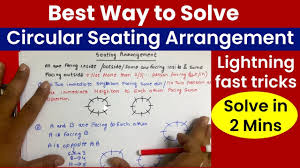Ever felt overwhelmed while solving reasoning problems in bank exams? These puzzles can seem confusing at first glance, especially when people face the ones that involve positioning and direction. The arrangement types in reasoning sections are designed to challenge observation and deduction. That is why many aspirants find this topic difficult during timed mock tests.
Once the concept is understood, circle seating arrangement questions become more predictable and manageable. With clear logic, step-by-step strategies, and sufficient practice, these questions stop being confusing and start becoming opportunities to score high. In this article, we will explore how to gain better clarity, build accuracy, and attempt these problems confidently in competitive exams.
Practice Mock Tests with Timed Strategy
Solving circle-based puzzles becomes easier with regular timed practice. Simulating exam-like conditions helps improve response time and accuracy. Start with easier problems and gradually move to moderate and high-difficulty ones. Keep a log of mistakes and review them weekly to avoid repeating the same errors. Try to solve one puzzle without stopping, then check the solution and draw comparisons. Focus on the thought process and where it slowed down. Improving speed does not mean skipping logic but recognizing patterns faster.
Understand the Flow Before Jumping to Conclusions
Instead of rushing into drawing diagrams, it helps to pause and read each statement carefully. Every sentence builds on the previous one, and missing just one detail may cause incorrect placement. Start by identifying the fixed information, such as the number of people or any person facing a certain direction. Marking the key points like ‘to the immediate left’ or ‘second to the right’ brings clarity. It is also important to distinguish between people sitting facing the center and those facing outward.
Draw Neat and Reusable Diagrams
Drawing is one of the most crucial parts of solving circle-based questions. Begin with a clean circle and label positions in clockwise or anticlockwise order. If it is unclear whether a person is facing inward or outward, draw arrows to indicate the direction. Maintain enough space between marks to avoid cluttering the setup. In case multiple possibilities arise, draw parallel diagrams neatly side by side. Avoid overwriting or scratching out, as that often causes errors in logic. Good diagram practices not only save time but also increase accuracy.
Track Directions and Relative Positions Carefully
Most errors happen when the direction of facing is misunderstood. Facing the center means left is anticlockwise, and right is clockwise. When someone faces outward, this is reversed. These details are critical and must be consistently followed throughout the setup. One helpful technique is to label directions with small arrows around the circle. This helps visualize orientation quickly. Also, keep an eye on terms like ‘immediate,’ ‘second to the left,’ or ‘sitting opposite.’ They can easily be mixed up under pressure. Directional clarity gives an edge over others during time-limited sections.
Use Elimination to Narrow Down Options
Sometimes, two or three statements give possibilities but not final positions. In such cases, elimination becomes useful. Start with the most restricted possibilities and rule out what cannot be true. Gradually, this will reveal the only workable arrangement. Even if the exact position of a person cannot be confirmed at first, placing others may narrow it down. Do not get stuck on one person’s position; move on to the next clue. Eventually, the earlier confusion may get resolved automatically as other spots get filled. This skill improves with repeated practice and is crucial for time management.
Confidently solving circle seating arrangement questions requires a blend of strategy, logic, and calm execution. Once the fundamentals are strong and direction-based thinking becomes second nature, performance improves naturally. Every puzzle solved with focus builds readiness for the next, and consistent improvement brings visible success in competitive reasoning sections.


